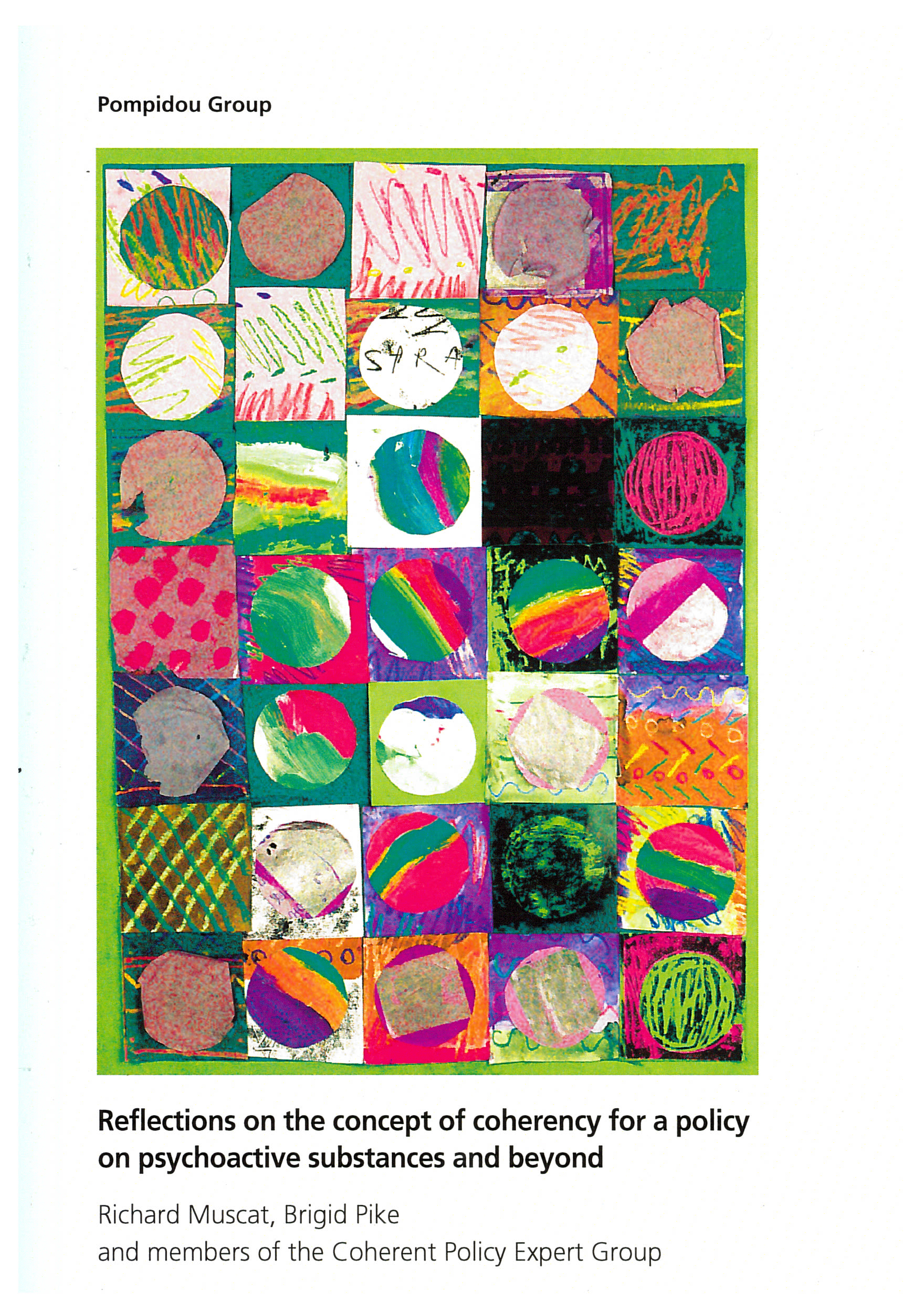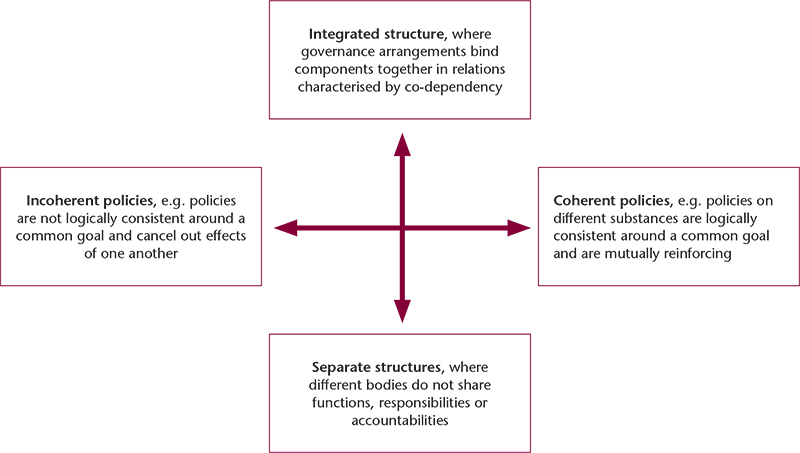Pike, Brigid
(2012)
Combining drug and alcohol policies – ‘a big challenge’.
Drugnet Ireland,
Issue 42, Summer 2012,
pp. 3-4.
‘It is still too easy to compartmentalise the elements for which organisations are responsible, but when it comes to an issue such as drug or alcohol use, it crosses all those boundaries. … We know from our prevention work that what are needed are not only programmes but also systems that can work together, … That is where we need to go, but it is a big challenge. I do not think anyone has cracked that yet.’
Mary Ellen McCann, Vice-Chair of the NACD,
speaking to the Joint Committee on Health and Children,
2 September 2011
In April 2012 the Council of Europe published the third in a series of reports intended to help ‘crack the big challenge’, exploring what structures and systems might support integrated policies on psychotropic substances (including illicit drugs, alcohol and tobacco).1 The three reports are the result of the ongoing deliberations of an ‘expert group’ set up under the auspices of the Pompidou Group.2
The first two publications from the expert group focused on the ‘context’ within which the combining of policies on illicit drugs, alcohol and tobacco may be considered,3 and the ’systems’ that could support the integration of policies in these three areas.4 This third report focuses on ‘measurement’.
Measuring substance misuse policies
In order to measure the extent to which different policies are combined, the expert group has agreed that all policies need to be goal-directed, to lead to a valid outcome as a result of their implementation. It identifies two ‘formidable’ goals for policies relating to illicit drugs, alcohol and tobacco – (1) the ‘well-being’ of the targeted population and (2) prevention of the harm/s caused by substance use.
The expert group goes on to explore the relationship between integration and coherence as a way of measuring the achievement of the policy outcomes. Integration is about combining parts into a single, unified whole, while coherence is about sticking a number of different parts together in a logically consistent manner. The former is like a chemical process, irreversible, with the whole being greater than the parts, while the latter is more like a physical process, reversible, in which the elements can be separated out again. The expert group suggests that ‘integration’ may be used to assess policy-making structures while ‘coherence’ may be used to assess policies, and the extent to which they align with each other around common goals and are mutually supportive while retaining their individual and separate characters – see diagram below.
The group suggests that gauging the extent of integration is useful for getting a broad-brush understanding of a particular set of policy and structural arrangements, their character. Gauging the degree of coherence around a common goal yields a more detailed, more fine-grained picture, which may increase the capacity of policy makers to respond flexibly as a policy domain changes over time, i.e. the framework may be a tool for policy makers to both understand the overall nature of their policy approach and also to manage their policies in a timely and responsive manner.
Coherency of Irish policies on tobacco, illicit drugs and alcohol
The report proposes a formal definition of ‘policy coherence’ and identifies six ’indicators’ that may be used to gauge the degree of coherency between policies on different substances. It also explores the validity, feasibility and practicality of using this concept in the psychotropic substances policy domain. Proceeding from this basis, each member of the expert group has written a chapter, reflecting on the coherency of drug, alcohol and tobacco policies in their own countries, including Austria, Belgium, Ireland, Israel, Netherland, Norway, Portugal and Switzerland.
In the case of Ireland, a preliminary assessment against the six proposed indicators or, more accurately perhaps, ‘markers’, of coherency suggests that tobacco is the policy area most consistently aligned with a population-based approach to health. Defining tobacco use as a public health problem, and one causing a substantial number of deaths, Ireland’s tobacco policy focuses on prevention, of both individual use and environmental exposure to tobacco smoke. Research and monitoring are also designed and undertaken to support effective prevention efforts. A population-based health approach has also been used when planning responses to problematic illicit drug use. However, on account of the criminal activities and public disorder, anti-social behaviour and violence that may be associated with illicit drugs, criminal justice responses have also been adopted. While these responses may achieve the desired criminal justice outcomes, such as a lower incidence of violent crime or safer communities, they may also serve to undermine the population health ethos by criminalising and/or stigmatising problem drug users. With regard to alcohol policy, considerable ambivalence was found. With no overall strategy in place (at the time the report went to press) to guide decisions, responses have included self-regulation, licensing and criminal justice measures. Moreover, implementation has been inconsistent.
While the assessment methodology may not lead to a precise measure of policy coherency, it does facilitate identification of options for strengthening the impact of different policies relating to the misuse of psychoactive substances.
1. Muscat R, Pike B and members of the Coherent Policy Expert Group (2012) Some reflections on the concept of coherency in relation to a policy on psychoactive substances and beyond. Strasbourg: Council of Europe Publishing.
2. The Co-operation Group to Combat Drug Abuse and Illicit Trafficking in Drugs (Pompidou Group) was an inter-governmental body formed in 1971 at the initiative of the late French President Georges Pompidou. In 1980 the Group was incorporated into the institutional framework of the Council of Europe and at present it comprises 35 member states. Its core mission is to contribute to the development of multidisciplinary, innovative, effective and evidence-based drug policies in its member states.
3. See Pike B (2008) Illicit drugs, alcohol and tobacco – understanding the policy issues. Drugnet Ireland, (29): 3–4.
4. See Pike B (2011) Merging policies on psychoactive substances. Drugnet Ireland, (39): 8–9.

